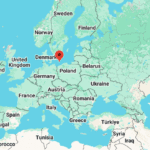By Simba Munyua
Harare, Zimbabwe – Citing escalating global tensions and economic uncertainty, Zimbabwe’s central bank has made a surprise decision to maintain its bank policy rate at a high of 35%. The move, announced by Reserve Bank Governor John Mushayavanhu on Monday, comes despite a previously scheduled rate-setting meeting later this month on June 27th.
“The MPC noted the broad-based deceleration of global growth occasioned by escalating trade tensions, geo-economic fragmentation, regional and international conflicts and policy uncertainty,” Mushayavanhu explained in a statement. “Considering the challenging and rapidly evolving risks to the global growth outlook, the MPC advised the Reserve Bank to maintain a sufficiently tight monetary policy stance.”
Despite the cautious outlook for the global economy, the bank remains optimistic about Zimbabwe’s domestic performance, projecting a 6% growth rate for the year. This optimistic forecast is largely attributed to a strong performance in the agricultural sector, driven by improved output from key crops like corn, tobacco, and cotton.
“Other sectors are also expected to record positive growth performance, benefiting from the prevailing price and exchange rate stability,” Mushayavanhu added.
Zimbabwe’s decision to hold the line on interest rates follows a previous hike last September intended to stabilize the newly introduced Zimbabwe Gold (ZiG) currency following a sharp devaluation. The tight monetary policy has had a noticeable impact, with the ZiG now used in 43% of transactions within the economy, up from 26% in April.
However, the high interest rates have drawn criticism from the business community, who argue that the tight monetary policy is creating a severe liquidity crunch. Despite these concerns, the central bank insists that its policy is necessary to maintain the stability of the ZiG.
The foreign currency reserves backing the ZiG currently stand at $701 million as of last Friday.
The International Monetary Fund (IMF) recently voiced support for the ZiG to become the sole currency in the Zimbabwean economy. The ZiG represents the nation’s sixth attempt at establishing a viable local currency since 2009, underscoring the ongoing challenges of economic stability in the southern African nation. This latest move by the central bank indicates a commitment to navigating global headwinds while prioritizing the stability and adoption of the ZiG currency.









